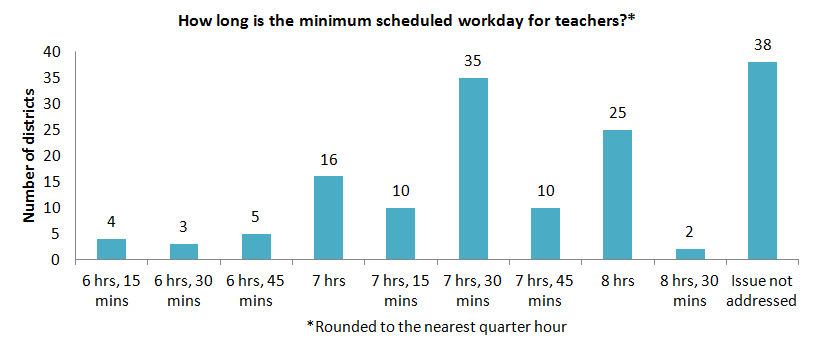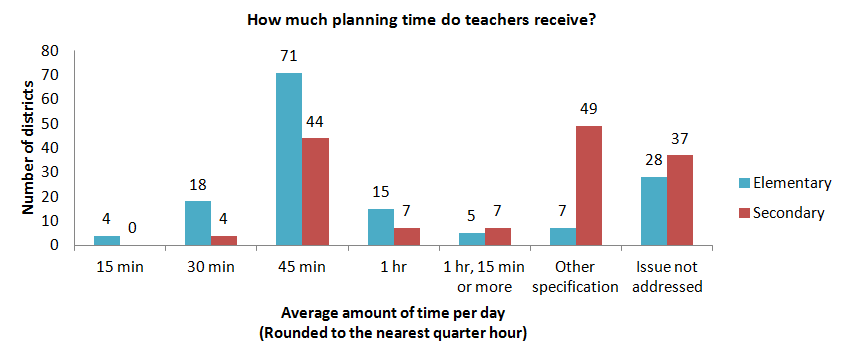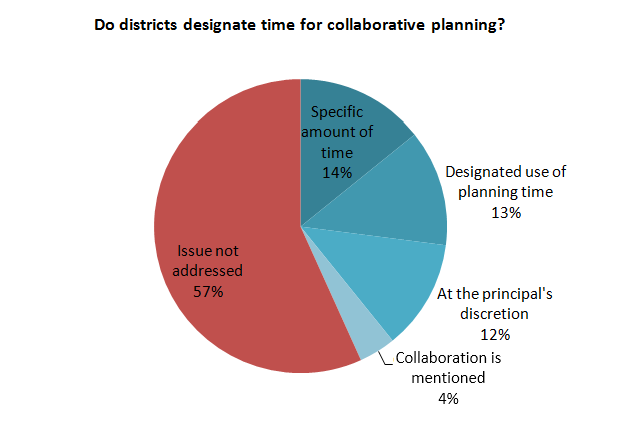District Trendline, previously known as Teacher Trendline, provides actionable research to improve district personnel policies that will strengthen the teacher workforce. Want evidence-based guidance on policies and practices that will enhance your ability to recruit, develop, and retain great teachers delivered right to your inbox each month? Subscribe here.
In order to be well prepared for daily instruction, teachers
need time without students to plan and collaborate. This month, Trendline delves into how long the teacher workday is and how much of that time
is devoted to planning and collaboration.
Length of workday
The average scheduled teacher workday across the 148 districts
in our database is seven and a half hours. There are, however, 38 districts in
our database that do not define the length of the workday in any of the standard
documents we collect.

When we last considered the length of the teacher workday in
2012, 86
percent of districts for which we had data had workdays of at least seven
hours. Since that time, we added several more districts to the Teacher Contract
Database. Based on our sample of districts today, 89 percent have workdays of
at least seven hours, an increase of three percentage points.
Henrico County (VA) and Sioux Falls (SD) are the two
districts where teachers’ scheduled workday is longer than eight hours, while
teachers in New York City, Sacramento, Jefferson Parish (LA), and Toledo (OH) have the shortest
scheduled workdays at six hours and fifteen minutes.
Planning time
Although the majority of a teacher’s workday involves
teaching students, an important aspect of a teacher’s day is planning time.
Just like last year,
the most common amount of planning time teachers receive is 45 minutes per day.

When it comes to elementary teachers’ planning time, those
in Montgomery County (MD) receive the
most at a minimum of 7 hours per week or an average of 84 minutes per day. For
secondary teachers, those in Chicagoreceive the most planning time at an average of 100 minutes per
day.
Many districts define planning time in terms of periods. In
the graph above, among the 49 districts listed as having an “other specification”
for secondary teachers, 43 give teachers one period of planning time per day. Guilford County (NC) is also
counted in this category and is the only district that explicitly leaves
teacher planning time up to each school (though that may well be the policy of
the 38 districts that are silent on this issue).
Collaboration time
While the majority of districts in the database
do not discuss collaboration time, nearly half (43 percent) do mention
collaboration in their bargaining agreements or board policies. Of these
districts, roughly one third define specific amounts of time for teacher
collaboration, another third explicitly mention collaboration as one use of general
planning time, and the final third either mention collaboration as important or
say that principals may designate some portion of general planning time for
collaboration.

Among the 21 districts that set aside time specifically for
collaboration, most offer between 45 to 60 minutes per week for collaboration. In
Dayton, secondary teachers get 30
minutes of collaboration time daily while the issue is not addressed for
elementary teachers. In Christina (DE), elementary teachers
receive a maximum of 90 minutes per week for collaboration and secondary
teachers receive a minimum of 90 minutes per week. In some districts, like Davis (UT), students have a shorter
day once per week to allow time for teachers to collaborate.
To learn more about planning time and collaboration, or one
of the more than 100 other policy questions we track, visit the Teacher
Contract Database.
The Teacher Contract Database includes information on over 145 school
districts in the United States: the 60
largest districts in the country, the largest district in each state, the member
districts of the Council of Great City Schools, and districts which won the
Broad Prize for Urban Education. The database features answers to over 100
policy questions and provides access to teacher contracts, salary schedules,
and board policies in addition to relevant state laws governing teachers.
